AIRFRAMES, ENGINES AND SYSTEMS—PART I
- AIRFRAMES, ENGINES AND SYSTEMS—PART I
Definitions
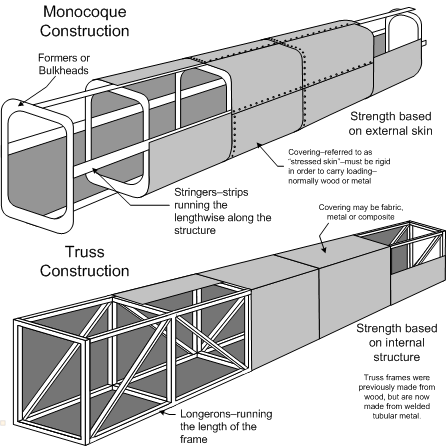
There are two primary definitions to be aware of, the first being “aircraft,” which is any “machine capable of deriving support in the atmosphere from the reactions of the air.” By comparison, the more specific category of “aeroplane” denotes any “power-driven heavier-than-air aircraft, deriving its lift in flight from aerodynamic reactions on surfaces that remain fixed during flight.”
A final commonly used term is “airframe” which is the aeroplane structure, excluding instruments and engine.
Parts of an Aeroplane
Fuselage
The fuselage denotes the central body of the aeroplane where passengers and cargo are housed.
Two types of fuselage construction exist, the first referred to as truss construction, which consists of longerons (tubes running length-wise) that are braced by beams to form a truss. The second is monocoque construction, which entails formers or bulkheads, joined by stringers (strips running length-wise), and surrounded by a stressed skin. The stressed skin is designed to be load-bearing, and it is this feature which differentiates it from traditional truss construction. As part of pilot pre-flight inspection, examination of stressed skin provides indication of the structural soundness of the fuselage.
Wing
The wing is the primary source of aerodynamic lift; the wing also houses fuel tanks. The main structural and load-bearing component of the wing is the spar, which extends from wing tip to wing root, where it is attached to the fuselage.
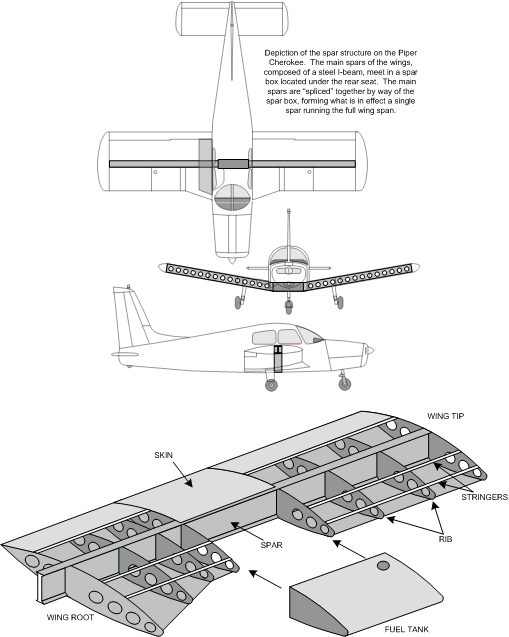
Differentiation is made between wings with one spar (monospar), and wings with multiple spars (multispar). Primary control surfaces are located on the wing, including the ailerons (which create roll), and the flaps (which provide control of lift and drag).
In addition to wing root and tip, a wing also consists of a leading edge and trailing edge.
With respect to internal structure, wing loading is transmitted to the spar by way of ribs, which extend from the leading to trailing edge, intersecting the spar.
Two types of wing designs are distinguished: wings that are externally braced to the fuselage by struts, and wings lacking struts. Wings without struts are referred to as cantilever wings.
Tail
The tail, also referred to as the empennage, provides pitch (nose-up and nose-down) control, as well as yaw control (nose-left and nose-right). The tail also provides longitudinal stability (keeping the tail behind the head).
The tail consists of two parts, the horizontal stabilizer, and vertical fin; the elevator control surface is attached to the horizontal stabilizer (allowing pitch control), and the rudder control surface is attached to the vertical fin (allowing yaw control).
With respect to the horizontal stabilizer and the attached elevator, a second design, referred to as a stabilator, allows the pilot to control pitch by moving the entire horizontal surface. This is common on Piper aircraft.
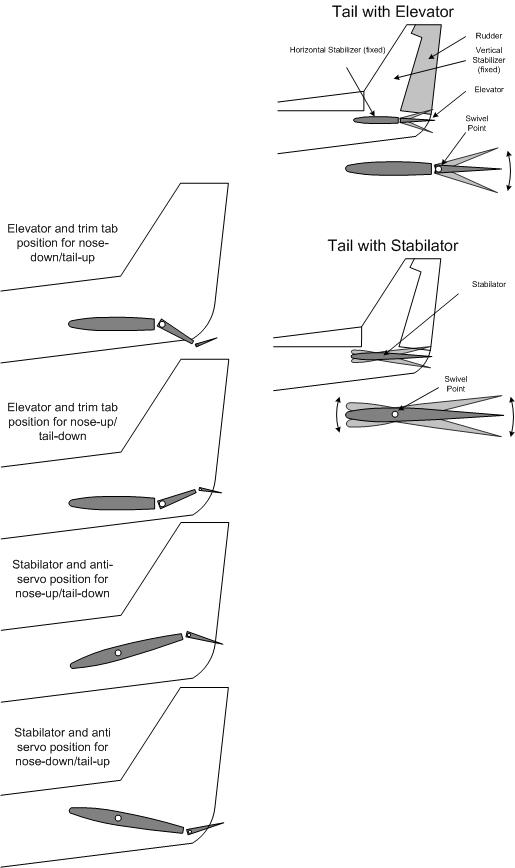
To assist the pilot in maintaining a desired nose-up or nose-down attitude, both elevators and stabilators have a design feature which utilizes aerodynamics to “pre-set” either of these control features. The process of pre-setting the tail for either nose-up or nose-down is referred to as trimming. For elevators, the mechanism is referred to as a trim tab, while the mechanism built into stabilators is referred to as an anti-servo tab.
To trim an aircraft equipped with an elevator for a nose-up position, referred to as a nose-up attitude, the elevator must be defected upwards, which lowers the tail and simultaneously raises the nose. Utilizing aerodynamics, however, the trim tab attached to the elevator can maintain an upward elevator if trim tab is set downward. This truly is a tricky concept to grasp, but it goes like this: an upward deflection of the trim tab as the effect of lowering the elevator, and the lowering of the elevator has the effect of raising the nose.
To trim an aircraft equipped with a stabilator for a nose-up attitude, the trailing edge of the stabilator must rise; to complete this task, the anti-servo tab attached to the trailing edge must be deflected downward
Propulsion
Propulsion systems on aircraft include three categories: internal combustion engines, jet and turbine engines, and turboprops (turbine engines with an attached propeller).
The engine is draped in cowling to reduce drag and control air-cooling; additionally, the engine is separated from the remaining airframe, including fuel storage areas, by a firewall. The “vital actions” of the pilot in response to an engine fire is always done accordance with the Pilot Operating Handbook, and always entails turning off cabin heat and window defrosting—if these actions are not done, the fire may spread past the firewall through these openings.
Undercarriage
There are four types of undercarriage (landing gear): split axle, tripod, single-leaf cantilever, or single strut (see From the Ground Up).
A more fundamental variation in undercarriage is conventional and tricycle gear—the former having a tail wheel, and the latter having a nose wheel.
While conventional gear provides greater manoeuvrability, there are the risks of the aircraft performing a “nose-over,” or “ground looping” (tail moving sideways out of control). Conventional gear also presents decreased visibility during aircraft taxi and takeoff.
In contrast, tricycle gear provide increased control in cross-wind takeoffs and landings; but the design also has ground hazards such as wheelbarrowing on the nose, and “porpoising.” Tricycle gear provides increased drag (slowing the aircraft down), is more expensive to maintain, and is not as strong as conventional gear.
Load and Load Factors
Pilots must be extremely conscious of structural load and load factors. During manoeuvring in the air, the loading on the aircraft—and thus the loading stress placed upon the structural components of the aircraft—are continually in transition. You must be aware how the loading changes, and aware that structural failure will result if the load limits are exceeded.
A load factor is simply a weight ratio of the “dead load” (aircraft on the ramp) to the “live load” (in motion). On the ramp, without motion, the aircraft weighs 1 times its gravity weight—say 2000 lbs. This changes, however, whenever the aircraft is accelerating/decelerating, climbing/descending, or during turns. In fact the only time an aircraft weighs 1 times its gravity weight (referred to as 1 “g”) is when it is in straight and level flight at a constant airspeed.
During a climb, the aircraft has increased weight as it moves away from the earth. During turns or pitch changes, the aircraft is subject to centrifugal force. Consider that in a level 30°-banked turn (wings 30° off the horizon), the aircraft weighs 1.15 times it gravity weight (1.15g). The same aircraft, including its occupants, weighs 2.0g in a level 60° banked turn, and 5g in level 80° banked turn—that is to say, the 2000 lb. aircraft on the ground now weighs 4000 lbs. and 10,000 lbs., respectively. For this reason, with the exception of fighter and aerobatic aircraft, pilots attempt to manoeuvre aircraft very gently, paying close attention to load factors.
Load factor variation is closely related to airspeed. A rapid pitch-up movement that produces maximum lift in an aircraft travelling 2-times its stall speed will produce a force on the aircraft equal to 4 g; the same manoeuvre in an aircraft travelling 4 times its stall speed will exert a force of 16g!
An aircraft’s yield load factor is when the structure will begin to bend and become distorted; its ultimate load factor is when the wings break off.
Fortunately, Transport Canada enforces Aircraft Certification Standards for normal category aircraft (as opposed to experimental category aircraft) that requires the aircraft meet load standards prior to its being certified.
Normal and Utility Categories
Most general aviation aircraft can be operated in what are referred to as the normal and utilitycategories; these are commonly referred to as aircraft loading categories.
The normal category enables a pilot to operate his or her aircraft at its maximum permissible gross weight provided that certain heavy load manoeuvres are not flown—spins, steep turns, etc. Following these restrictions, he is ensured the aircraft will withstand 3.8g positive and 1.52 negative.
The pilot can also operate the same aircraft in the utility category, whereby he or she is less restricted in manoeuvres that can be flown (e.g., spins and stalls are approved) provided the aircraft is kept in much narrower weight and loading restrictions; in this utility category, the pilot is assured the aircraft can withstand 4.4g positive and 1.76g negative. The utility category would therefore be used extensively in training or practice flights.
Aerobatic aircraft can have even greater strength—aerobatic certification of an aircraft assures as high as 6g positive and 5g negative.
Manoeuvring Speed and Gust Loads
All pilots must be aware of “gust loads” typically associated with air turbulence. For pilots, one of the most important speeds is referred to as the manoeuvring speed (Va).
At or below an aircraft’s manoeuvring speed, the aircraft’s controls can be fully deflected without exceeding load limits.
As a rule, Vaequals 1.9 times the stall speed of the aircraft at gross weight. It is specifically published in individual aircraft’s Pilot Operating Handbook.
Since extreme turbulence can entail momentary acceleration, safe practice is to fly 10 knots (KTS) less than Va in turbulence.
Logbooks and Inspections
Each flight in an aircraft must be recorded in three logbooks—the Pilot’s Log, the aircraft’s Journey Log, and the aircraft’s Technical Logs.
Aircraft Technical Logs record maintenance, modifications, and installations, and are composed of three sub-logs: an Airframe Log (modifications and installations), an Engine Log, and a Propeller Log. Technical Logs are never transported on aircraft. The Engine Log records and documents all maintenance performed on the aircraft.
Journey Logs record aircraft destinations, flight crew, weight data, air time (total period of time from aeroplane leaving the surface to time of aeroplane landing), flight time (total period from time aeroplane moves under its own power to time the aircraft stops at the termination of flight), total airframe time, records of inspection, and defects or snags.
All maintenance recorded in the technical logs must be transcribed in the Journey Log. When intending to land and shutdown at an airport other than the airport of departure, the Journey Log must always be transported in aircraft and completed and signed by the Pilot-in-command following a flight.1
Certificates of Airworthiness
With the exception of hang gliders and ultra-lights, aircraft must have authority to fly (flight authority), and this authority is provided by Transport Canada is the form of a Certificate of Airworthiness.
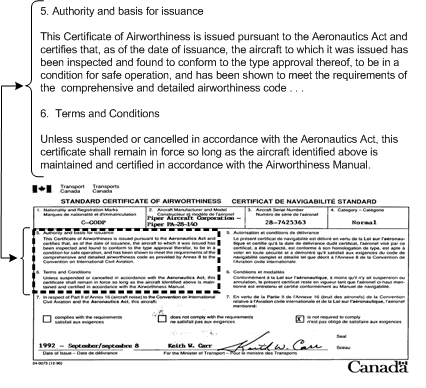
A Certificate of Airworthiness implies that a particular aircraft conforms to a type design that has been certified by the Transport Canada as safe for flight.2 They must be carried on board during flight.
Flight authority is provided by three means: a Standard certificate of airworthiness, a Special certificate of airworthiness, and Flight Permits.
Standard certificates are issued for aircraft that fully comply with all standards of airworthiness for normal aeroplanes, utility aeroplanes, aerobatic aeroplanes, transport aeroplanes, normal rotorcraft, transport rotorcraft, glider, powered glider, airships, and manned free balloons.
Aircraft not meeting the requirements for a standard certificate may be issued a Special certificate in any one of the following four classifications:3
|
Provisional |
Issued subject to conditions of operation. |
|---|---|
|
Restricted |
Issued when an aircraft has been modified for special purpose operations, such as aerial advertising, fire fighting, photography and survey, or crop application. |
|
Issued for aircraft manufactured by amateurs in accordance with airworthiness standards. Amateur-built aircraft are inspected by Transport Canada. |
|
|
Limited |
Issued for aircraft that have been accepted for use in the military and which are approved for private, non-commercial use. |
There are two types of Flight Permits, those for “experimental” flights engaged in aeronautical research, and those for “specific purpose.” Specific Purpose Permits are used for ferry flights where movement of the aircraft is necessary for repairs or maintenance, and are also used for the export and import of aircraft.
Non-airworthiness
If a pilot flies an aircraft that is not airworthy, he or she is flying in contravention of the law and will be subject to the appropriate consequences.
Perhaps more importantly, insurance protection does not cover aircraft operated in a non-airworthy state, and the pilot and operator would therefore be exposed to liability associated with property damage and personal injury.
Certificates of Airworthiness can be invalidated for a number of reasons, the most common being defective equipment.
All aircraft defects, irrespective of their effect on the aircraft airworthiness, must be entered in the Journey Log. When faced with a defect, the pilot is responsible to evaluate and determine whether airworthiness is undermined. In the case of a defective VHF radio in an aircraft equipped with two radios, airworthiness is not affected, yet the pilot must still describe the defective condition in the Journey Log, indicating his or her determination of the airworthiness state—e.g., “No. 1 Com U/S—aircraft airworthy.”
If the pilot is unsure of the state of airworthiness following detection of a defect, an Aircraft Maintenance Engineer should be consulted and the Journey Log signed accordingly.
Less obviously, a certificate of airworthiness is invalidated if the pilot fails to operate the aircraft in accordance with the Pilot Operating Handbook—i.e., overloads an aircraft, or fails to conduct the required pre-flight inspection.
Certificates of Airworthiness can also be invalidated if the aircraft is not maintained as per one of the two accepted schedules of maintenance: the manufacturer’s recommendations or Transport Canada’s recommendations.4
If maintained as per the manufacturer’s recommendations, the scheduled maintenance will be described in the aircraft’s maintenance manual, and will often entail inspections for every 50 hours, 100 hours, 200 hours, etc., of air time.
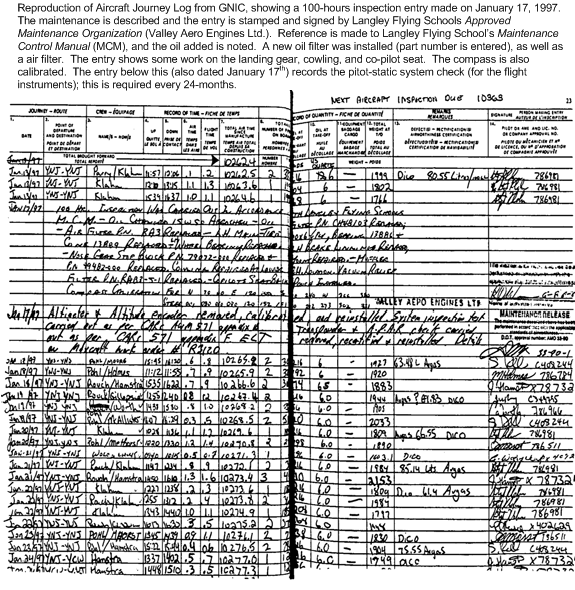
In contrast, when maintained in accordance with Appendix B of Canadian Aviation Regulation 625, private aircraft requires an annual inspection (at least once every 12 months), and commercial aircraft (small) require 100 hour inspections. If an aircraft is flown beyond a scheduled inspection, the Certificate of Airworthiness is not in effect (nor is there insurance protection). The required schedule of maintenance can be determined from historic entries in the Journey Log.
It should be noted that the maintenance of commercial aircraft, including the aircraft of a Flight Training Unit such as Langley Flying School, are additionally governed by the Unit’s Maintenance Control Manual, a copy of which must be carried on board each aircraft. The Maintenance Control Manual contains specific rules that must be followed in the event of defective equipment and scheduled or unscheduled maintenance.
Airworthiness Directives
When Transport Canada becomes aware of service difficulties with particular aircraft it can issue what is referred to as an Airworthiness Directive (AD). If applicable to your aircraft type, or if applicable to any type of component on the aircraft or engine, the AD will outline the rectification maintenance that must be undertaken to remedy the problem, and the time line within which the maintenance must be undertaken.5
ADs are sent out via mail to all registered owners of applicable aircraft, based on records maintained by Transport Canada. Importantly, compliance is the legal responsibility of the aircraft owner, and non-compliance renders an aircraft non-airworthy.
An AD may apply to particular serial numbers of the aircraft type, or serial numbers equipment contained on the aircraft (e.g., radios, flight instruments, engines, propellers, seat belts, etc.).
AD compliance must be recorded in the Journey Log and transcribed in the technical records. Proper technical record-keeping is crucial in dealing with ADs so that the applicability of, or compliance with, an AD can be quickly determined with mere reference to entries made in the technical records. When purchasing an aircraft, it is critical to examine the aircraft’s technical records to ensure historic AD compliance.6
Service Bulletins
Service bulletins are published by the aircraft or equipment manufacturer and are not automatically sent to the registered owner; service bulletin compliance is not mandatory, but non-conformity with service bulletins could raise issues for an owner’s liability with respect to unsafe operation of an aircraft.
Pilot Operating Handbooks
Pilot Operating Handbooks are the manufacturer instructions on how to operate and maintain a particular aircraft.
Pilot Operating Handbooks are periodically amended by the manufacturer but the amendments are not automatically forwarded to the registered owner; for this reason an owner should contact the manufacturer regularly (once a year, for example) to determine if any amendments have occurred.
Pilot Maintenance
According to Canadian Aviation Regulation 605.85, no person shall conduct a takeoff in an aircraft, or permit a takeoff to be conducted (in the case of an aircraft owner or operator) following any maintenance (other than “elementary work” described below) unless a maintenance release has been signed by an AME whereby the following is stated: “The maintenance described above has been performed in accordance with the applicable standards of airworthiness.” (For commercial aircraft, maintenance release statements are required as per the operator’s Maintenance Control Manual.)
An exception to this concerns elementary work performed in accordance with CAR 625.85 (Appendix A), where an AME’s signature is not required. Authorisations for the performance of elementary work is the responsibility of the aircraft owner, and elementary work by a person other than an AME can only be conducted on piston-engine, unpressurized aeroplanes, with less than 12,500 lbs. maximum allowable takeoff weight, and not engaged in commercial operations. With respect to aircraft not operated in a commercial service, elementary work is limited to the following:
- fabric patches measuring not more than 15 cm (6 in) in any direction and not requiring rib stitching or the removal of control surfaces or structural parts;
- removal and installation of tires, wheels, landing skids or skid shoes, not requiring separation of any hydraulic lines;
- removal and installation of skis on fixed landing gear, not requiring separation of any hydraulic lines;
- removal and installation of seats, safety belts and harnesses;
- repair of non-structural fairings, cover plates and cowlings;
- repair of upholstery and cabin trim;
- removal and installation of glider wings and tail surfaces that are designed for quick assembly;
- removal and installation of co-pilot flight control levers and pedals that are designed for quick removal and installation;
- cleaning and installation of spark plugs;
- checking of cylinder compression;
- cleaning or changing of fuel, oil, and air filters;
- draining and replenishing engine oil;
- adjustment of generator or alternator drive belt tension;
- removal and installation of aircraft batteries;
- checking the electrolyte level and specific gravity of lead acid batteries;
- removal and installation of fuses, light bulbs and reflectors;
- removal and installation of parts of communications equipment that are line replaceable units (LRUs) designed for rapid replacement;
- installation of anti-misfuelling devices to reduce the diameter of fuel tank filler openings, when the installation does not involve disassembly of the existing fuel filler opening, drilling, riveting or welding.
The full details of any of the above maintenance must be entered in the Journey Log and signed by the person performing the work.7
All other maintenance on the aircraft must be performed by an appropriately endorsed Aircraft Maintenance Engineer, who must sign a Maintenance Release in the Journey Log and other appropriate maintenance logs. If the Maintenance Release is not signed, the aircraft Certificate of Airworthiness is not in effect.
The owner or operator of the aircraft is required to maintain the records of maintenance performed, including the Journey Log and all technical logs.
References
3 CAR 507.03.
4 As specified in Appendix B of Canadian Aviation Regulation 625, “Aircraft Equipment and Maintenance Standard.”
5 The time line can be based on hours flown, or it can be based on a specified date. In rare cases, immediate rectification may be specified.
6 Transport Canada maintains a website that includes a complete AD-search feature. Just follow the links
.jpg)

